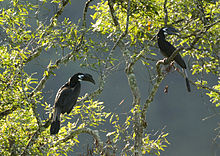
Hornbills are birds found in tropical and subtropical Africa, Asia and Melanesia of the family Bucerotidae. They are characterized by a long, down-curved bill which is frequently brightly coloured and sometimes has a horny casque on the upper mandible. Hornbills have a two-lobed kidney. They are the only birds in which the first and second neck vertebrae are fused together; this probably provides a more stable platform for carrying the bill. The family is omnivorous, feeding on fruit and small animals. They are monogamous breeders nesting in natural cavities in trees and sometimes cliffs. A number of mainly insular species of hornbill with small ranges are threatened with extinction, namely in Southeast Asia.

Anthracoceros is a genus of birds in the family Bucerotidae.
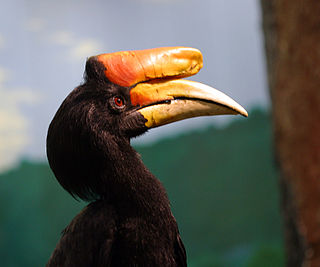
Buceros is a genus of large Asian hornbills.
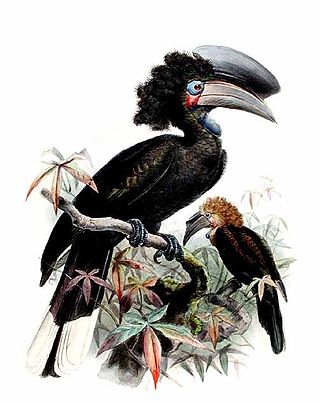
Ceratogymna is a genus of large, primarily frugivorous hornbills found in the humid forests of Central and West Africa. They are sexually dimorphic: males are all black, while females have brown heads and a smaller casque. Unlike the members of the genus Bycanistes, the two species in the genus Ceratogymna have extensive, primarily blue, bare facial skin and dewlap, and the only white in their plumage is in the tail.

Ocyceros is a genus of birds in the family Bucerotidae. Established by Allan Octavian Hume in 1873, it contains several species that are limited to the Indian subcontinent.

Penelopides is the genus of relatively small, primarily frugivorous hornbills restricted to forested areas of the Philippines. Their common name, tarictic hornbills, is an onomatopoetic reference to the main call of several of them. They have a ridged plate-like structure on the base of their mandible. All are sexually dimorphic: males of all species are whitish-buff and black, while females of all except the Mindoro hornbill are primarily black.

Bycanistes is a genus of medium to large, primarily frugivorous hornbills found in the forests and woodlands of Sub-Saharan Africa. They have often been included in the genus Ceratogymna, but today most authorities consider them separate. All species in this genus have black and white plumage. The plumage of the sexes is similar, but the casque of the male is larger than that of the female.

The African grey hornbill is a member of the hornbill family of mainly tropical near-passerine birds found in the Old World. It is a widespread resident breeder in much of sub-Saharan Africa and the southwest of the Arabian Peninsula. The African grey hornbill has escaped or been deliberately released into Florida, USA, but there is no evidence that the population is breeding and may only persist due to continuing releases or escapes.
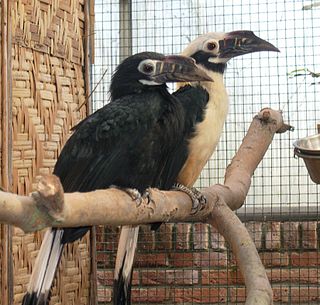
The Visayan hornbill is a hornbill found in rainforests of Western Visayas region which includes the islands of Panay, Negros,Cebu and Guimaras, as well as the island of Masbate, and formerly Ticao, in the Philippines. It formerly included all other Philippine tarictic hornbills as subspecies, in which case the common name of the 'combined species' was shortened to tarictic hornbill.

The Mindanao hornbill, sometimes called the Mindanao tarictic hornbill, is a medium-small species of hornbill found in the canopy of rainforests on Mindanao, Dinagat, Siargao and Basilan in the southern Philippines. As is the case with all Philippine tarictic hornbills, it has been considered a subspecies of P. panini. The Samar hornbill is often included as a subspecies of the Mindanao hornbill.
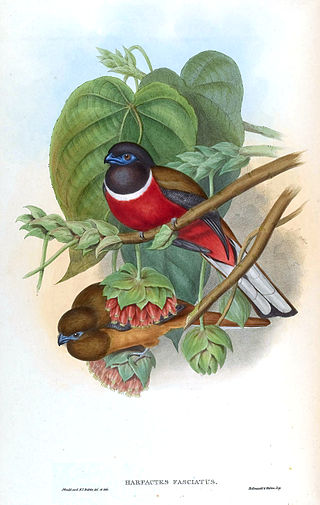
Harpactes is a genus of birds in the family Trogonidae found in forests in South and Southeast Asia, extending into southernmost China. They are strongly sexually dimorphic, with females generally being duller than males. Their back is brownish, the tail is partially white, and males of most species have red underparts. They feed on arthropods, small lizards and fruit.
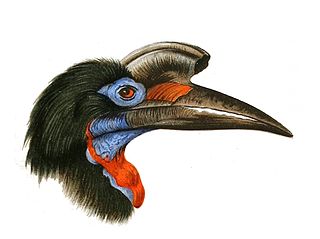
The ground hornbills (Bucorvidae) are a family of the order Bucerotiformes, with a single genus Bucorvus and two extant species. The family is endemic to sub-Saharan Africa: the Abyssinian ground hornbill occurs in a belt from Senegal east to Ethiopia, and the southern ground hornbill occurs in southern and East Africa.
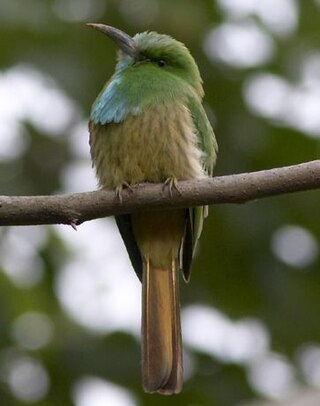
Nyctyornis is a genus of the bee-eaters, near passerine birds in the family Meropidae. There are just two members of this group, which occur in tropical south and southeastern Asia.

Bucerotiformes is an order of birds that contains the hornbills, ground hornbills, hoopoes and wood hoopoes. These birds were previously classified as members of Coraciiformes. The clade is distributed in Africa, Asia, Europe and Melanesia.

The Sulawesi hornbill, also known as the Sulawesi tarictic hornbill, Temminck's hornbill or Sulawesi dwarf hornbill, is a relatively small, approximately 45 cm (18 in) long, black hornbill. The male has a yellow face and throat, and yellowish horn bill with black markings. The female has all-black plumage and a darker bill.
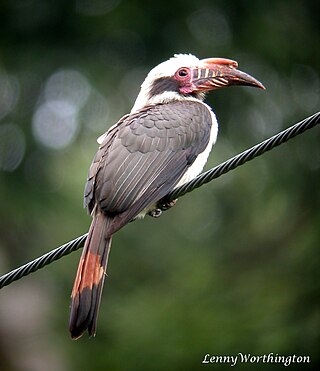
The Luzon hornbill, sometimes called Luzon tarictic hornbill, is a species of hornbill in the family Bucerotidae. It is endemic to forests on Luzon and nearby islands in the northern Philippines. As is the case with all Philippine tarictic hornbills, it has been considered a subspecies of P. panini.
The Samar hornbill is a species of hornbill in the family Bucerotidae. It is found in forests on the islands of Samar, Calicoan, Leyte and Bohol in the east-central Philippines. As is the case with all Philippine tarictic hornbills, it has been considered a subspecies of P. panini. Alternatively, it is considered a subspecies of P. affinis.

Apalharpactes is a genus of birds in the family Trogonidae. They are restricted to humid highland forest on the Indonesian islands of Java and Sumatra. Unlike all other Asian trogons, their plumage is mainly green above and yellow below. Compared to most trogons, the sexual dimorphism is relatively small. The two species in the genus resemble each other, but A. reinwardtii is larger than A. mackloti, and the male A. mackloti has a chestnut rump-patch, which A. reinwardtii lacks. They feed on arthropods, small lizards and fruit.

Rhyticeros is a genus of medium to large hornbills found in forests from Southeast Asia to the Solomons. They are sometimes included in the genus Aceros. On the other hand, most species generally placed in Aceros are sometimes moved to Rhyticeros, leaving Aceros as a monotypic genus only containing the rufous-necked hornbill.
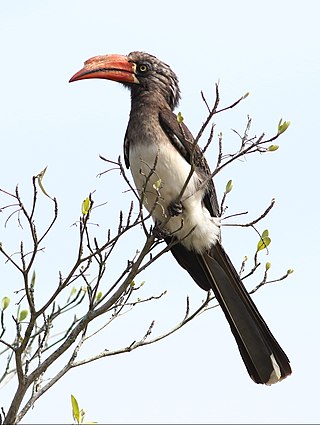
Lophoceros is a genus of birds in the hornbill family, Bucerotidae, which are native to Africa.
